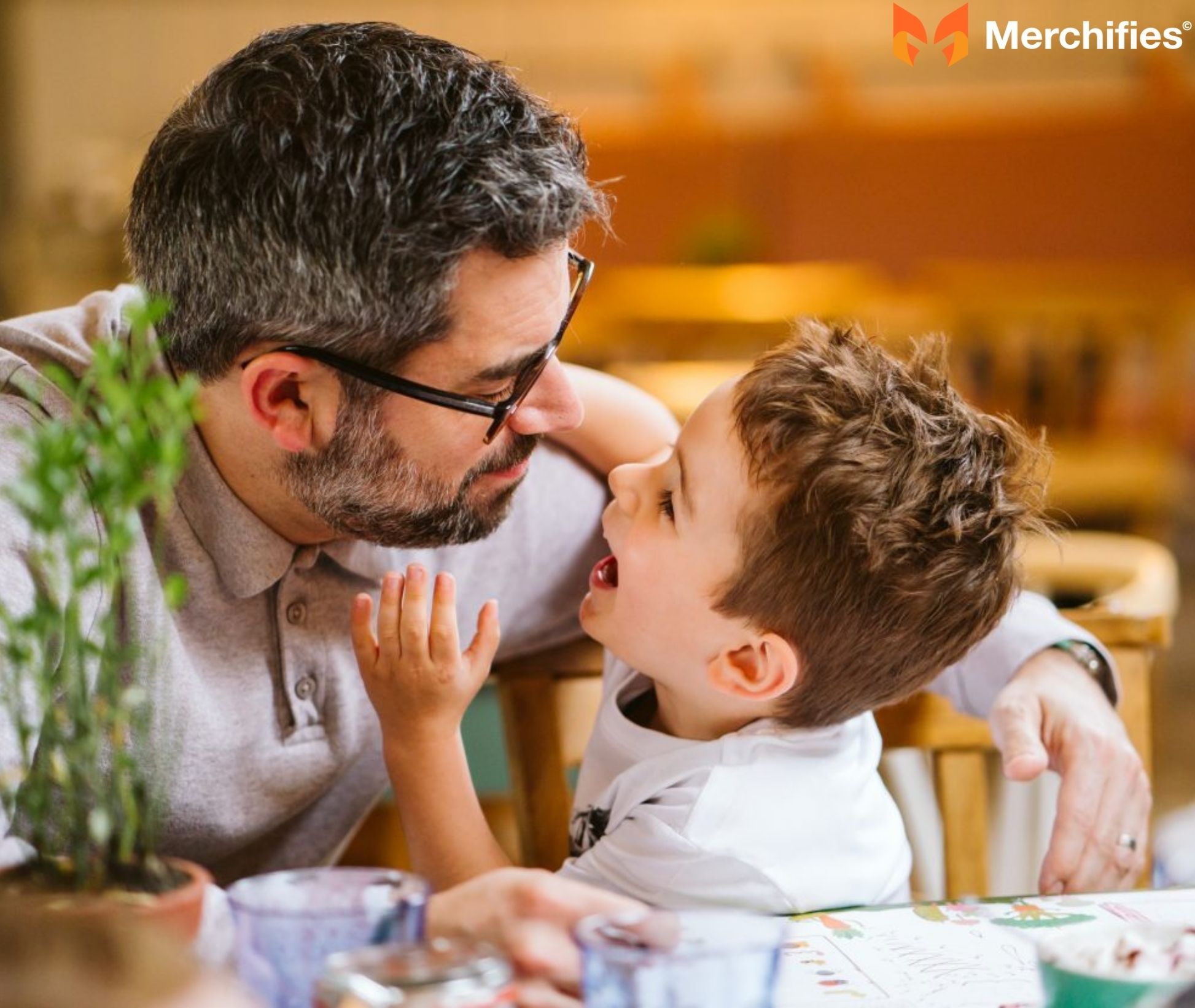The History of Father’s Day & Its Modern Gift Trends
Discover the history of Father’s Day and today’s modern gift trends — from its heartfelt origins to creative, personalized presents dads truly appreciate.

Blog Post Contents
Paternal love is a cornerstone of family life, offering guidance, support, and a unique brand of affection. Just as we celebrate mothers, fathers too deserve a special day to recognize their profound impact. From heartfelt cards to dad shirts for Father’s Day, the ways we honor fatherhood have become deeply symbolic. But how did this tradition begin, and what led to the fascinating evolution of Father's Day gifts? As a seasoned expert in cultural history and someone who has extensively researched family traditions, Evelyn Sage shares insights into the rich and somewhat complex origin story of Father's Day, from a heartfelt local tribute to a nationally observed holiday. This article will journey through the holiday's inception, its winding path to national recognition, and the ever-changing landscape of gift-giving traditions, ultimately deepening our appreciation for this cherished day.
The Seeds of a Special Day: How Father's Day Started
The idea of honoring fathers didn't simply appear overnight; it blossomed from individual initiatives and persistent advocacy. Understanding how Father's Day started reveals a fascinating grassroots effort that slowly gained national momentum.
The First Unofficial Observances: A Community's Heartfelt Tribute
The earliest sparks of Father's Day often go unnoticed but are crucial to its origin. The first known observance of a day dedicated to fathers took place in July 1908 in Fairmont, West Virginia. Grace Golden Clayton, mourning the loss of her own father and many others in a tragic mining accident, organized a special Sunday service to remember the nearly 400 men who had perished, most of whom were fathers. While deeply significant to the Fairmont community, this memorial was largely a local event and didn't immediately spread beyond the town's borders.
The more organized and influential push, widely credited for the holiday's establishment, came two years later in Spokane, Washington. Sonora Smart Dodd, inspired by a Mother's Day sermon in 1909, felt strongly that fathers deserved similar recognition. Her own father, William Smart, a Civil War veteran, had single-handedly raised her and her five siblings after their mother's death. To honor him, Dodd campaigned tirelessly, approaching local churches, the YMCA, shopkeepers, and government officials. Her efforts led to the first city-wide Father's Day celebration in Spokane on June 19, 1910, chosen to coincide with her father's birthday month. This event marks a pivotal moment in how Father's Day started, laying the groundwork for broader acceptance.
The Long Road to National Recognition: From Local Idea to Presidential Endorsement
Despite Spokane's success, the path to national recognition for Father's Day was anything but direct. Early presidential interest provided crucial visibility: President Woodrow Wilson endorsed the idea in 1916, even participating in a Spokane celebration, and President Calvin Coolidge urged state recognition in 1924, though he stopped short of issuing a national proclamation.
However, the concept faced considerable resistance and skepticism. Many worried about the potential for rampant commercialization, viewing it as a contrived holiday primarily for retailers. Others dismissed it as a mere imitation of Mother's Day, suggesting that if parents needed a joint celebration, a single "Parent's Day" would suffice. These arguments created a lengthy delay in the holiday's official acceptance.
Paradoxically, the two World Wars played a significant role in bolstering support for honoring fathers. During both WWI and WWII, celebrating fathers was promoted as a way to acknowledge their contributions to the war effort and their importance in maintaining family stability during challenging times. This shift in public sentiment helped reshape perceptions, highlighting fathers as essential figures for both family and nation.
When Was Father's Day Officially Recognized? Nixon's Proclamation (1972)
The eventual success of Father's Day can be attributed to decades of persistent lobbying. Various groups, including trade organizations and men's wear retailers who saw the holiday's commercial potential, continuously advocated for its official recognition. Their efforts, combined with evolving societal views on fatherhood, finally paid off.
In 1972, President Richard Nixon signed a congressional resolution and issued a proclamation, officially making Father's Day a permanent national holiday in the United States. This historic act designated that Father's Day would be observed annually on the third Sunday in June. This pivotal moment cemented the holiday's place in the American calendar, marking the culmination of a movement that had spanned more than six decades.

From Sentiment to Shopping Cart: The History of Father's Day Gifts
Just as the holiday itself evolved, so too did the history of Father's Day gifts. What began as simple, symbolic gestures transformed into a robust commercial tradition, mirroring shifts in culture and consumerism.
Early Forms of Appreciation: The Symbolic Rose
In the nascent days of Father's Day, particularly during the time of Sonora Smart Dodd's initial efforts, the primary tradition was wearing a rose. A red rose was worn to honor a living father, while a white rose signified a deceased father. This simple, heartfelt gesture served as a powerful symbol of remembrance and honor, long before the advent of widespread commercial gifting. These early forms of appreciation focused on sentiment rather than material possessions.
The Rise of Commercialization: Post-WWI and Depression-Era Marketing
It wasn't long before businesses recognized the economic potential of Father's Day. After World War I and especially during the Great Depression, retailers saw an opportunity to boost sales during what was typically a slower period for consumer spending. The history of Father's Day gifts truly took a commercial turn as trade groups, such as the "Father's Day Council" formed in the 1930s, actively began promoting gift-giving. Their marketing campaigns encouraged families to buy presents for their fathers, shifting the focus from purely symbolic gestures to tangible items.
The Iconic "Dad Gifts": Ties, Tools, and Beyond
With increased commercialization, certain items quickly became synonymous with Father's Day. The necktie, for instance, emerged as the quintessential Father's Day gift. Aggressive marketing campaigns positioned ties as a practical, respectable, and universally acceptable present for the working man. As Evelyn Sage explains, this period was crucial in shaping the conventional wisdom around Father's Day gifts, moving from simple gestures to specific product categories.
Beyond ties, practicality often dictated gift choices. Tools, fishing gear, workwear, and other "masculine" items gained significant popularity. Advertisements of the era frequently depicted fathers enjoying their new wrench sets or fishing rods, reinforcing the idea that the best way to show appreciation was through gifts that supported a father's hobbies or work. This emphasis on practicality over pure sentiment reflected the societal role of fathers during much of the 20th century. So, what were the first Father's Day gifts in the commercial sense? It was often these utility-focused items.
Modern Father's Day Gifts: Personalization, Experiences, and Tech
Today's history of Father's Day gifts reflects a more diverse and personalized approach. While traditional gifts like ties and tools still have their place, there's a clear shift toward items that are more tailored to individual tastes, offer unique experiences, or embrace cutting-edge technology.
Personalized items have soared in popularity, ranging from engraved gadgets and custom apparel to photo books and bespoke accessories. Experiential gifts, such as concert tickets, sporting event outings, cooking classes, or weekend getaways, are also highly valued, offering shared memories rather than just material goods. Technology plays a massive role, with gadgets, smart home devices, and gaming equipment frequently topping wish lists. Furthermore, the concept of a "father figure" has expanded, with gifts often extended to grandfathers, stepfathers, uncles, and mentors, acknowledging the diverse forms of paternal influence in our lives. These modern Father's Day traditions celebrate the individual and the unique bond shared.

The Enduring Significance of Father's Day
Beyond the gifts and celebrations, Father's Day continues to hold deep cultural and personal meaning.
Shifting Perceptions of Fatherhood
The holiday also mirrors the evolving perceptions of fatherhood itself. For much of its history, the ideal father was often portrayed as the stoic breadwinner. However, contemporary society increasingly celebrates fathers as engaged caregivers, active participants in child-rearing, and emotionally connected partners. Father's Day now serves as an important occasion to acknowledge and celebrate these diverse and evolving forms of fatherhood, honoring men who embody care, strength, and commitment in various ways.
Global Celebrations and Unique Traditions (Brief Mention)
While this article primarily focuses on the origin of Father's Day in the U.S., it's worth noting that many countries around the world have their own unique ways and dates for honoring fathers. From St. Joseph's Day in some Catholic countries (March 19) to different observances across Europe, Asia, and Latin America, the spirit of gratitude for fathers is a universal one, even if the Father's Day traditions vary.

Frequently Asked Questions About Father's Day History & Gifts
This section addresses common questions about the holiday's background and gift-giving practices, offering quick, direct answers.
Who is credited with starting Father's Day?
While Grace Golden Clayton held the first known observance in Fairmont, WV, in 1908, Sonora Smart Dodd is widely recognized for her persistent efforts that led to its widespread establishment, organizing the first city-wide celebration in Spokane, WA, in 1910.
What were the first Father's Day gifts?
The earliest form of honoring fathers was not a material gift, but a symbolic gesture: wearing a rose – red for living fathers and white for deceased fathers. Tangible gifts came later with the commercialization of the holiday.
Why is Father's Day celebrated on the third Sunday in June?
This date was largely influenced by Sonora Smart Dodd's initial celebration month (June, to coincide with her father's birthday) and was officially designated as the permanent national holiday by President Richard Nixon in 1972 through a presidential proclamation.
How did neckties become a common Father's Day gift?
Neckties gained popularity through aggressive marketing by the Father's Day Council and retailers in the early to mid-20th century. They were positioned as a respectable, practical, and appropriate gift for the working man, quickly becoming an iconic symbol of the holiday.
Conclusion: A Day of Gratitude, Past and Present
From a heartfelt community memorial to Sonora Smart Dodd's visionary campaign, and finally to presidential proclamation, the journey of Father's Day is a testament to the enduring desire to honor the paternal figures in our lives. The history of Father's Day gifts has mirrored this evolution, transitioning from symbolic roses to practical tools, and now embracing personalized items, experiential offerings, and cutting-edge technology. This comprehensive understanding, as meticulously laid out by Evelyn Sage, not only enriches our appreciation for the day but also highlights the evolving nature of familial love and societal recognition. Beyond the gifts, the essence of Father's Day remains a profound expression of gratitude and recognition for the dedication, guidance, and love that fathers and father figures provide, making it a truly special day on our calendar.